2009 RENAULT TWINGO RS instrument panel
[x] Cancel search: instrument panelPage 3 of 348

17B-3V7 MR-413-X44-17B000$010.mif
PETROL INJECTION
Fault finding – Introduction17B
SIM 32 Injection
Program no.: D3
Vdiag No.: 44, 4C, 50
and 54
3. REMINDERS
Procedure
For MODUS vehicles:
To run fault finding on the vehicle's computers, switch on the ignition in fault finding mode (+ after ignition feed).
For CLIO III vehicles:
To run fault finding on the vehicle computers, switch on the ignition.
Depending on the type of vehicle equipment, proceed as follows:
To cut off the + after ignition feed, proceed as follows:
For NEW TWINGO vehicles:
To run fault finding on the vehicle computers, switch on the ignition. Proceed as follows:
–turn the ignition key to APC,
–connect the diagnostic tool and perform the required operations.
To cut off the + after ignition feed, proceed as follows:
–disconnect the diagnostic tool,
–turn the ignition key to OFF,
–verify that the forced + after ignition feed has been switched off by checking that the computer warning lights on
the control panel have gone out. For vehicles with key/radiofrequency remote control unit,
switch on the ignition with the key.
For vehicles with a Renault card,
insert the vehicle card in the card reader.
press and hold the start button (longer than 5 seconds) with start-up conditions not fulfilled,
connect the diagnostic tool and perform the required operations.
For vehicles with key/radiofrequency remote control unit,
switch off the ignition with the key.
For vehicles with a Renault card,
press the Start button twice briefly (less than 3 seconds),
ensure that the + after ignition feed has been cut off by checking that the computer indicator lights on the instrument
panel have gone out.
Page 10 of 348
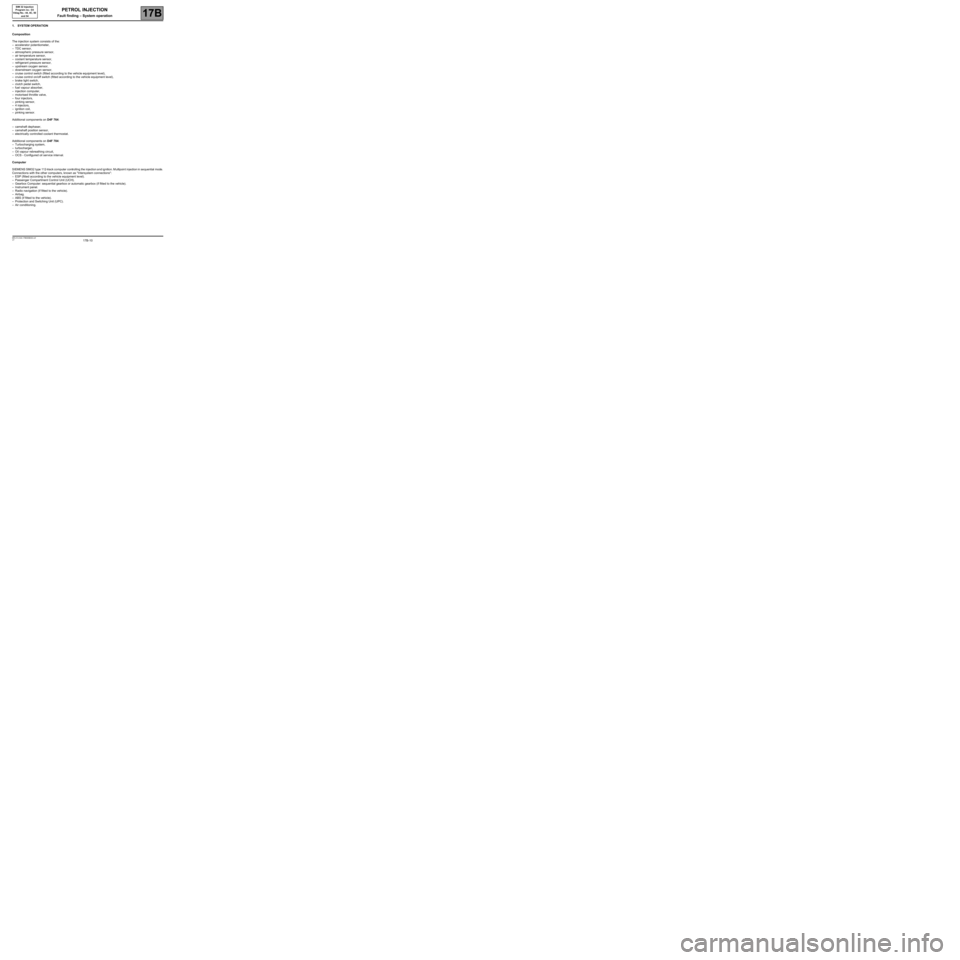
17B-10V7 MR-413-X44-17B000$030.mif
17B
SIM 32 Injection
Program no.: D3
Vdiag No.: 44, 4C, 50
and 54
1. SYSTEM OPERATION
Composition
The injection system consists of the:
–accelerator potentiometer,
–TDC sensor,
–atmospheric pressure sensor,
–air temperature sensor,
–coolant temperature sensor,
–refrigerant pressure sensor,
–upstream oxygen sensor,
–downstream oxygen sensor,
–cruise control switch (fitted according to the vehicle equipment level),
–cruise control on/off switch (fitted according to the vehicle equipment level),
–brake light switch,
–clutch pedal switch,
–fuel vapour absorber,
–injection computer,
–motorised throttle valve,
–four injectors,
–pinking sensor,
–4 injectors,
–ignition coil,
–pinking sensor.
Additional components on D4F 764:
–camshaft dephaser,
–camshaft position sensor,
–electrically controlled coolant thermostat.
Additional components on D4F 784:
–Turbocharging system,
–turbocharger,
–Oil vapour rebreathing circuit,
–OCS - Configured oil service interval.
Computer
SIEMENSSIM32type112-track co mputer controlling the injection a nd ignition. M ultipoint injection in se quential mode.
Connections with the other computers, known as "Intersystem connections":
–ESP (fitted according to the vehicle equipment level).
–Passenger Compartment Control Unit (UCH).
–Gearbox Computer: sequential gearbox or automatic gearbox (if fitted to the vehicle).
–Instrument panel.
–Radio navigation (if fitted to the vehicle).
–Airbag.
–ABS (if fitted to the vehicle).
–Protection and Switching Unit (UPC).
–Air conditioning.
PETROL INJECTION
Fault finding – System operation
Page 14 of 348
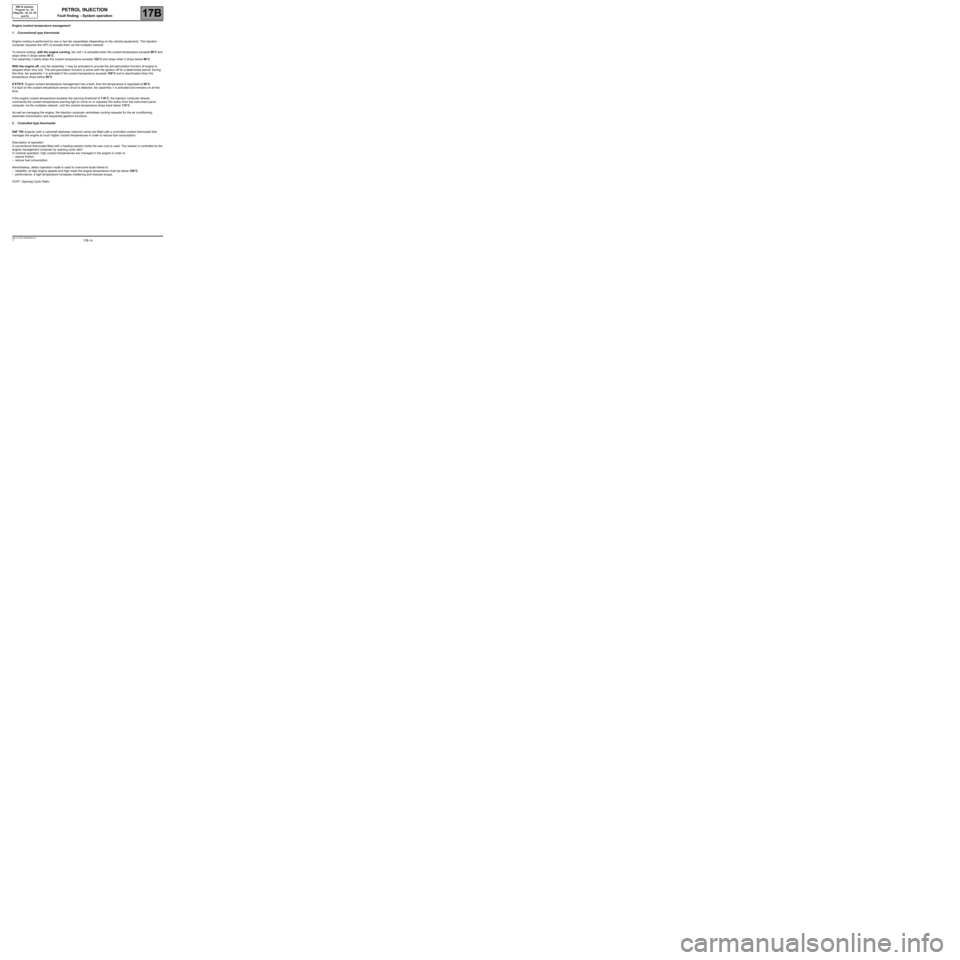
17B-14V7 MR-413-X44-17B000$030.mif
PETROL INJECTION
Fault finding – System operation17B
SIM 32 Injection
Program no.: D3
Vdiag No.: 44, 4C, 50
and 54
Engine coolant temperature management
1. Conventional type thermostat
Engine cooling is performed by one or two fan assemblies (depending on the vehicle equipment). The injection
computer requests the UPC to actuate them via the multiplex network.
To ensure cooling, with the engine running, fan unit 1 is activated when the coolant temperature exceeds 99˚C and
stops when it drops below 96˚C.
Fan assembly 2 starts when the coolant temperature exceeds 102˚C and stops when it drops below 99˚C.
With the engine off, only fan assembly 1 may be activated to provide the anti-percolation function (if engine is
stopped when very hot). The anti-percolation function is active with the ignition off for a determined period. During
this time, fan assembly 1 is activated if the coolant temperature exceeds 100˚C and is deactivated when the
temperature drops below 95˚C.
If ET672: Engine coolant temperature management has a fault, then the temperature is regulated at 90˚C.
If a fault on the coolant temperature sensor circuit is detected, fan assembly 1 is activated and remains on all the
time.
If the engine coolant temperature exceeds the warning threshold of 118˚C, the injection computer directly
commands the coolant temperature warning light to come on or requests this action from the instrument panel
computer via the multiplex network, until the coolant temperature drops back below 115˚C.
As well as managing the engine, the injection computer centralises cooling requests for the air conditioning,
automatic transmission and sequential gearbox functions.
2. Controlled type thermostat
D4F 764 engines (with a camshaft dephaser solenoid valve) are fitted with a controlled coolant thermostat that
manages the engine at much higher coolant temperatures in order to reduce fuel consumption.
Description of operation
A conventional thermostat fitted with a heating resistor inside the wax core is used. The resistor is controlled by the
engine management computer by opening cycle ratio*.
In nominal operation, high coolant temperatures are managed in the engine in order to:
–reduce friction,
–reduce fuel consumption.
Nevertheless, defect operation mode is used to overcome faults linked to:
–reliability: at high engine speeds and high loads the engine temperature must be below 100˚C,
–performance: a high temperature increases chattering and reduces torque.
OCR*: Opening Cyclic Ratio.
Page 16 of 348
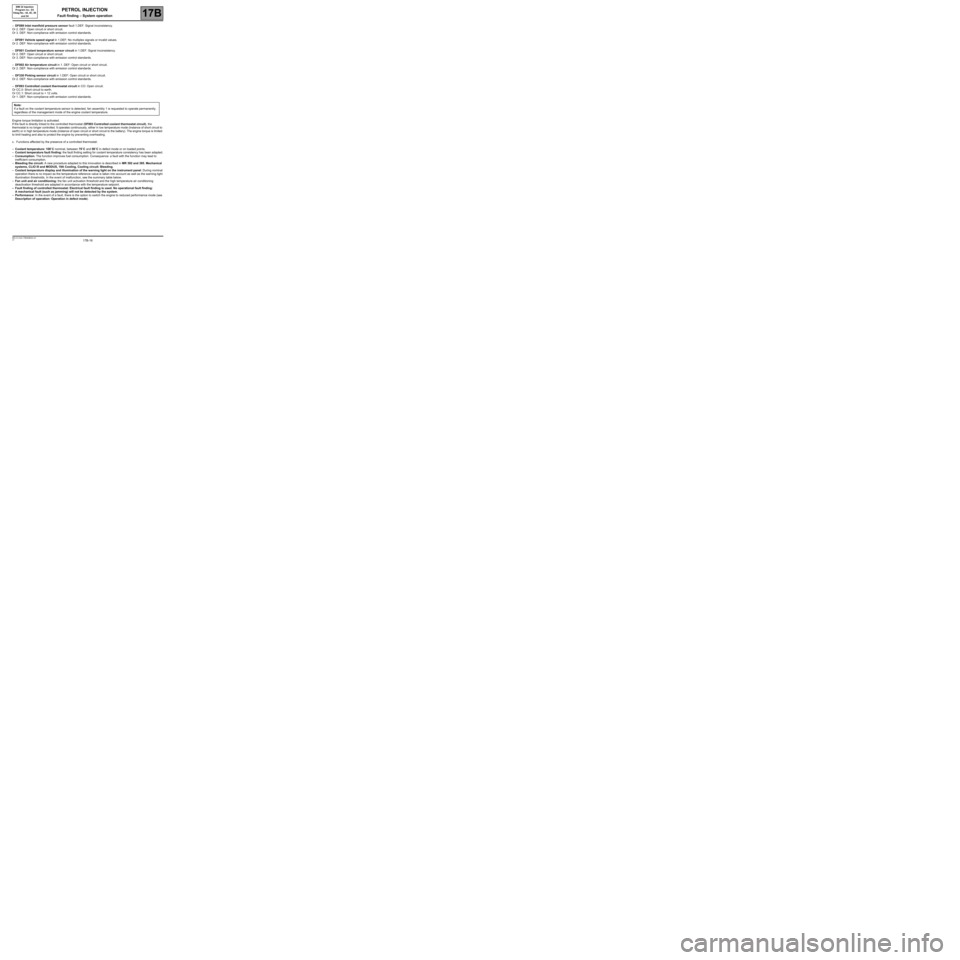
17B-16V7 MR-413-X44-17B000$030.mif
PETROL INJECTION
Fault finding – System operation17B
SIM 32 Injection
Program no.: D3
Vdiag No.: 44, 4C, 50
and 54
–DF089 Inlet manifold pressure sensor fault 1.DEF: Signal inconsistency.
Or 2. DEF: Open circuit or short circuit.
Or 3. DEF: Non-compliance with emission control standards.
–DF091 Vehicle speed signal in 1.DEF: No multiplex signals or invalid values.
Or 2. DEF: Non-compliance with emission control standards.
–DF001 Coolant temperature sensor circuit in 1.DEF: Signal inconsistency.
Or 2. DEF: Open circuit or short circuit.
Or 3. DEF: Non-compliance with emission control standards.
–DF002 Air temperature circuit in 1. DEF: Open circuit or short circuit.
Or 2. DEF: Non-compliance with emission control standards.
–DF330 Pinking sensor circuit in 1.DEF: Open circuit or short circuit.
Or 2. DEF: Non-compliance with emission control standards.
–DF893 Controlled coolant thermostat circuit in CO: Open circuit.
Or CC.0: Short circuit to earth.
Or CC.1: Short circuit to + 12 volts.
Or 1. DEF: Non-compliance with emission control standards.
Engine torque limitation is activated.
If the fault is directly linked to the controlled thermostat (DF893 Controlled coolant thermostat circuit), the
thermostat is no longer controlled. It operates continuously, either in low temperature mode (instance of short circuit to
earth) or in high temperature mode (instance of open circuit or short circuit to the battery). The engine torque is limited
to limit heating and also to protect the engine by preventing overheating.
c. Functions affected by the presence of a controlled thermostat:
–Coolant temperature: 108˚C nominal, between 70˚C and 90˚C in defect mode or on loaded points.
–Coolant temperature fault finding: the fault finding setting for coolant temperature consistency has been adapted.
–Consumption: The function improves fuel consumption. Consequence: a fault with the function may lead to
inefficient consumption.
–Bleeding the circuit: A new procedure adapted to this innovation is described in MR 392 and 385, Mechanical
systems, CLIO III and MODUS, 19A Cooling, Cooling circuit: Bleeding.
–Coolant temperature display and illumination of the warning light on the instrument panel: During nominal
operation there is no impact as the temperature reference value is taken into account as well as the warning light
illumination thresholds. In the event of malfunction, see the summary table below.
–Fan unit and air conditioning: the fan unit activation threshold and the high temperature air conditioning
deactivation threshold are adapted in accordance with the temperature setpoint.
–Fault finding of controlled thermostat: Electrical fault finding is used. No operational fault finding:
A mechanical fault (such as jamming) will not be detected by the system.
–Performance: In the event of a fault, there is the option to switch the engine to reduced performance mode (see
Description of operation: Operation in defect mode). Note:
If a fault on the coolant temperature sensor is detected, fan assembly 1 is requested to operate permanently,
regardless of the management mode of the engine coolant temperature.
Page 17 of 348
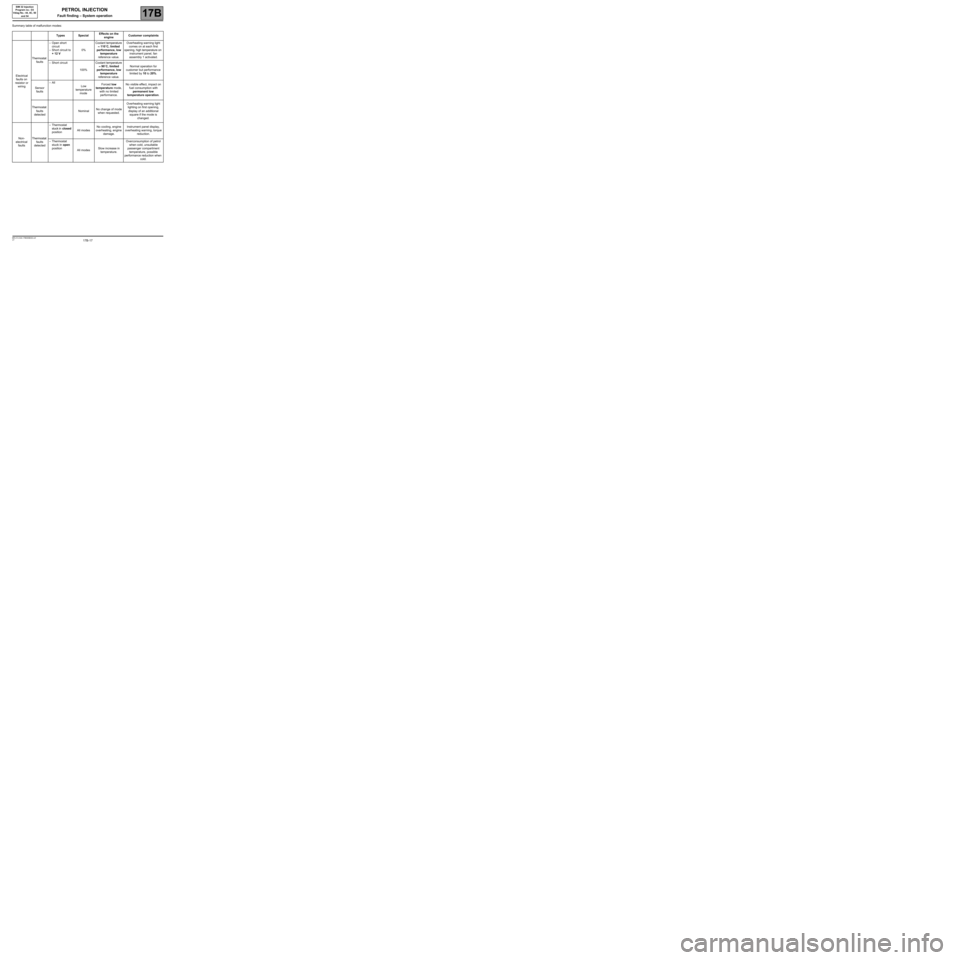
17B-17V7 MR-413-X44-17B000$030.mif
PETROL INJECTION
Fault finding – System operation17B
SIM 32 Injection
Program no.: D3
Vdiag No.: 44, 4C, 50
and 54
Summary table of malfunction modes:
Types SpecialEffects on the
engineCustomer complaints
Electrical
faults on
resistor or
wiringThermostat
faults–Open short
circuit
–Short circuit to
+ 12 V0%Coolant temperature
≈ 110˚C, limited
performance, low
temperature
reference value.Overheating warning light
comes on at each first
opening, high temperature on
instrument panel, fan
assembly 1 activated.
–Short circuit
100%Coolant temperature
≈ 90˚C, limited
performance, low
temperature
reference value.Normal operation for
customer but performance
limited by 10 to 20%.
Sensor
faults–All
Low
temperature
modeForced low
temperature mode,
with no limited
performance.No visible effect, impact on
fuel consumption with
permanent low
temperature operation.
Thermostat
faults
detectedNominalNo change of mode
when requested.Overheating warning light
lighting on first opening,
display of an additional
square if the mode is
changed.
Non-
electrical
faultsThermostat
faults
detected–Thermostat
stuck in closed
positionAll modesNo cooling, engine
overheating, engine
damage.Instrument panel display,
overheating warning, torque
reduction.
–Thermostat
stuck in open
position
All modesSlow increase in
temperature.Overconsumption of petrol
when cold, unsuitable
passenger compartment
temperature, possible
performance reduction when
cold.
Page 21 of 348

17B-21V7 MR-413-X44-17B000$050.mif
17B
SIM 32 Injection
Program no.: D3
Vdiag No.: 44, 4C, 50
and 54
RV* / LV*: Cruise control/Speed Limiter1 - Injection computer 16 - Upstream sensor signal
2 - RV* / LV* buttons 17 - Ignition command
3 - Multiplex network 18 - Bleed canister command
4 - Turbocharger 19 - Fuel pump command
5 - Motorised throttle 20 - Downstream sensor signal
6 - Manifold pressure 21 - ESP computer
7 - Injector command 22 - Rev counter computer
8 - Clutch Pedal 23 - ABS computer
9 - Brake pedal 24 - Instrument panel computer
10 - Accelerator pedal 25 - Sequential gearbox computer
11 - Refrigerant fluid pressure 26 - AIRBAG computer
12 - Air conditioning compressor command 27 - Vehicle speed sensor computer
13 - Engine cooling fan assembly command 28 - Air conditioning computer
14 - Flywheel signal 29 - UCH computer
15 - Pinking signal 30 – Turbocharging pressure
PETROL INJECTION
Fault finding – Functional diagram
Page 22 of 348
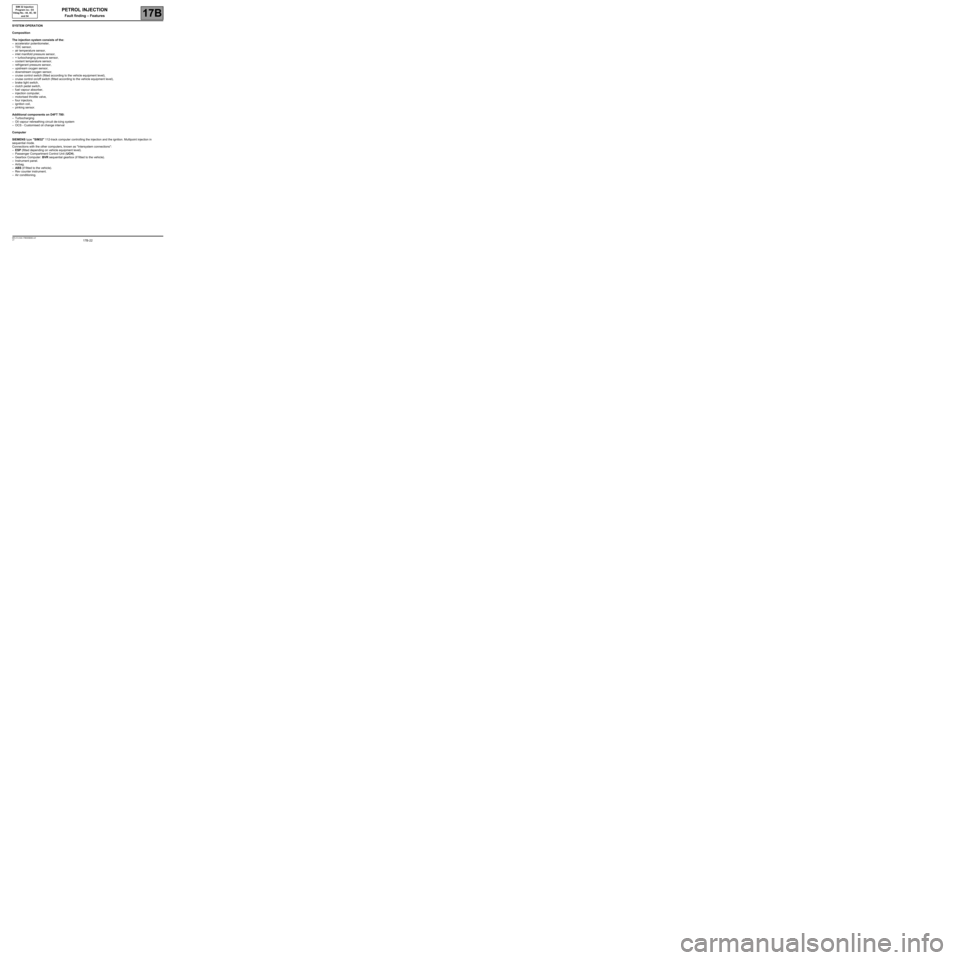
17B-22V7 MR-413-X44-17B000$060.mif
17B
SIM 32 Injection
Program no.: D3
Vdiag No.: 44, 4C, 50
and 54
SYSTEM OPERATION
Composition
The injection system consists of the:
–accelerator potentiometer,
–TDC sensor,
–air temperature sensor,
–inlet manifold pressure sensor,
–+ turbocharging pressure sensor,
–coolant temperature sensor,
–refrigerant pressure sensor,
–upstream oxygen sensor,
–downstream oxygen sensor,
–cruise control switch (fitted according to the vehicle equipment level),
–cruise control on/off switch (fitted according to the vehicle equipment level),
–brake light switch,
–clutch pedal switch,
–fuel vapour absorber,
–injection computer,
–motorised throttle valve,
–four injectors,
–ignition coil,
–pinking sensor.
Additional components on D4FT 780:
–Turbocharging
–Oil vapour rebreathing circuit de-icing system
–OCS - Customised oil change interval
Computer
SIEMENS type "SIM32" 112-track computer controlling the injection and the ignition. Multipoint injection in
sequential mode.
Connections with the other computers, known as "Intersystem connections":
–ESP (fitted depending on vehicle equipment level).
–Passenger Compartment Control Unit (UCH).
–Gearbox Computer: BVR sequential gearbox (if fitted to the vehicle).
–Instrument panel.
–Airbag.
–ABS (if fitted to the vehicle).
–Rev counter instrument.
–Air conditioning.
PETROL INJECTION
Fault finding – Features
Page 25 of 348

17B-25V7 MR-413-X44-17B000$060.mif
PETROL INJECTION
Fault finding – Features17B
SIM 32 Injection
Program no.: D3
Vdiag No.: 44, 4C, 50
and 54
Richness
For the catalytic converter to operate correctly, adjust around richness 1.
The richness regulation controlled by the upstream sensor which ensures a richness of around 1.
The upstream sensor supplies a voltage according to the image of the average engine richness: the voltage supplied
to the computer represents a Rich-Lean signal.
For the upstream sensor to be operational very rapidly, it is heated. The heating works only when the engine is
running. It is deactivated at speeds above 84 mph (140 km/h) or when the engine is under load.
The downstream sensor is also heated. The command does not activate immediately after starting the engine. It is
activated when the engine is running and has reached its operating temperature. The downstream heating sensor is
deactivated at speeds above 84 mph (140 km/h) or when the engine is under load.
Torque management
The torque structure is the system for managing engine torque. The torque structure is required for certain functions
such as the electronic stability program (ESP) or sequential gearbox (BVR).
Each computer (ESP, BVR) sends a request for torque via the multiplex network to the injection computer. This
intervenes between the torque requests received and the driver's requests (made via the pedal or the cruise control/
speed limiter function). The result of this intervention is the torque setpoint to be applied. Using the torque reference
value, the structure calculates the throttle position reference value and the ignition advance and if the turbocharging
function is present, calculates the turbocharging solenoid valve reference value.
Engine coolant temperature management
Engine cooling is performed by one or two fan assemblies (depending on the vehicle equipment). The injection
computer requests the UCH to actuate them via the multiplex network.
To provide cooling when the engine is running, activation of fan assembly 1 is requested if the coolant temperature
exceeds 99˚C and is deactivated when the temperature drops below 96˚C.
Fan unit 2 starts when the coolant temperature exceeds 102˚C and stops when it falls below 99˚C.
With the engine off, only GMV1 may be activated to provide the anti-percolation function (if engine is stopped when
very hot). The anti-percolation function is active with the ignition off for a determined period. During this time, fan
assembly 1 is activated if the coolant temperature exceeds 100˚C and is deactivated when the temperature drops
below 95˚C.
If the engine temperature exceeds the warning threshold of 118˚C, the injection computer directly commands the
coolant temperature warning light to illuminate or requests this action from the instrument panel computer via the
multiplex network, until the coolant temperature drops back below 115˚C.
As well as managing the engine, the injection computer handles cooling requirements for the air conditioning and
sequential gearbox functions.